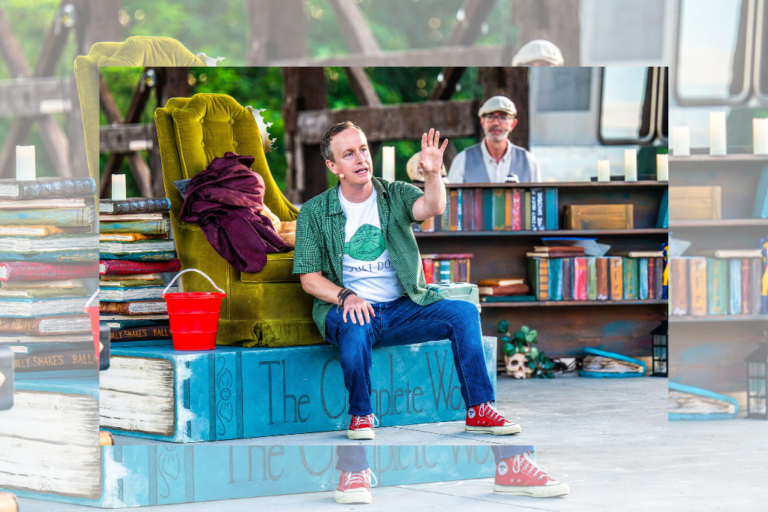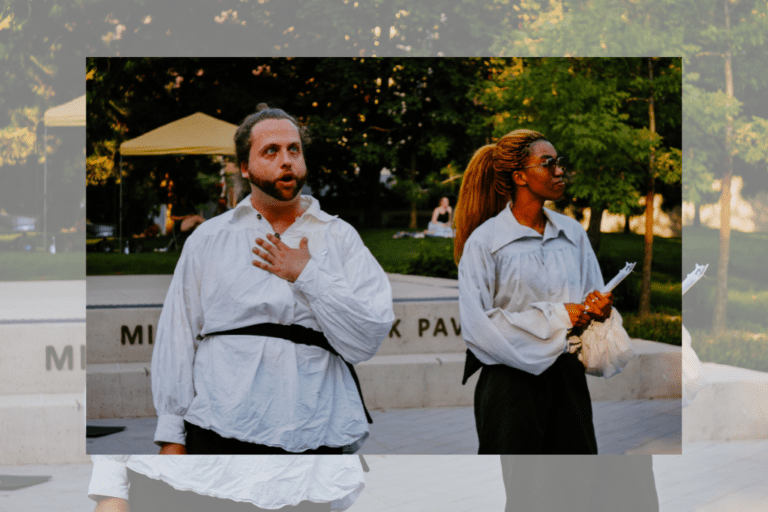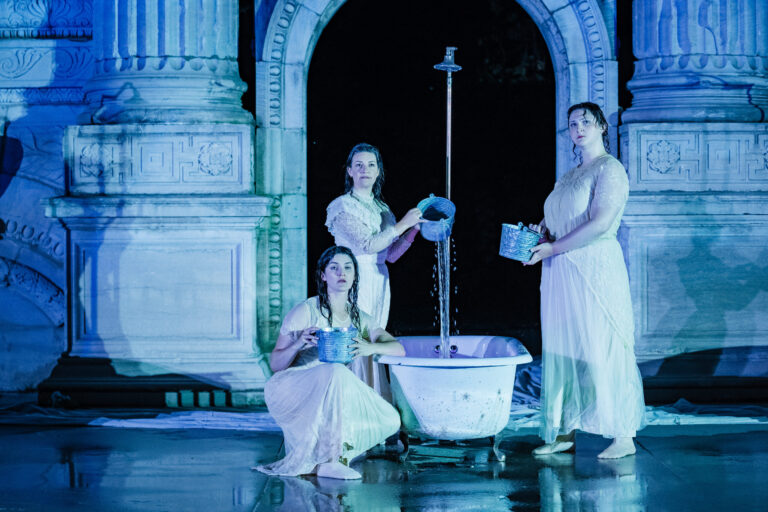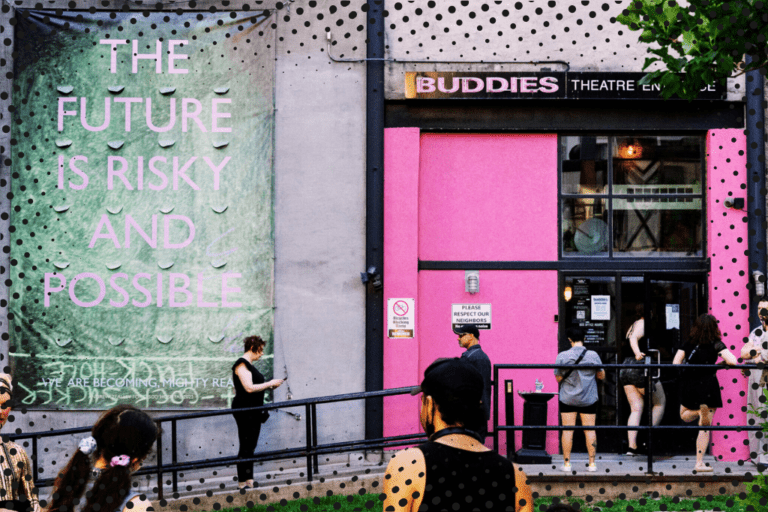Theatre Passe Muraille Asks: “How Do We Connect”?
Throughout the pandemic, the question haunting the theatre community has remained the same: When can we return to the theatre?
There are no reliable answers to this question. For more than fourteen months, the entire industry has blazed with an unsettled energy, jumping at every opportunity to return to the stage and re-experiencing the pain of loss with each subsequently cancelled show. But perhaps it’s time to take a step back from the return to traditional theatre, and ask ourselves a different question. What is theatre? How do we connect with each other, with our surroundings, and with theatre as an artform? Who are we to each other?
Two new works presented by Theatre Passe Muraille are exploring these very questions.
For both May I Take Your Arm? and Ephemeral Artifacts, the journey to their current form started long before the pandemic began. May I Have Your Arm?, first staged by Red Dress Productions in September 2018, is currently in its third iteration. The story began in May 2018, when Blind theatre artist Alex Bulmer returned to Canada after living in the UK for over fourteen years. Initially excited to be returning to the familiar and welcoming landscape of Toronto, it quickly became clear that in moving to Cabbagetown, a neighbourhood she had not regularly explored in the past, the landscape was anything but recognizable.
“Basically, I came, and I ended up in a place and I didn’t know where I was. I was feeling lost and disoriented, and the traditional methods of providing me an understanding of my space—traditional as in the kinds of services a blind person would get, orientation and mobility instructions, or sometimes people will make tactile maps—were all really useful, but I still felt like I had no sense of place or home,” said Bulmer.
Bulmer first reached out to Red Dress Productions to propose an audio project—perhaps a podcast. Her concept? Getting to know the neighbourhood through the senses, stories, and memories of the people who lived there. Bulmer would take a local’s arm, walk with them through the neighbourhood, and familiarize herself with it, not through a guided tour, but through storytelling. But in working with the Red Dress Productions team, the concept quickly evolved into a complete audio, spatial, and tactile experience.

Things fell into place miraculously well—two of Bulmer’s co-creators and the artistic co-directors of Red Dress Productions, Anna Camilleri and Tristan R. Whiston, had lived in Cabbagetown for over fifteen years and were intimately familiar with the area. According to Camilleri, “there was kind of a beautiful confluence of experiences in the project. Alex moved to Cabbagetown, where both Tristan and I not only lived, but had worked on projects that were socially engaged. We’d done a number of large site-specific public art projects, theatre projects… We realized that we could actually make some introductions.”
As a result of these walks, Bulmer recorded conversations with eight individuals, creating a tapestry of the Cabbagetown and St. James Town community. Young and old, new to Canada or a long-term resident, disabled and non-disabled—each story reflects a different aspect of the local community. Before the show, audiences were invited to interact with and touch carefully constructed, handmade models of the landmarks from Bulmer’s chats. The culmination of these stories and models intertwined with Bulmer’s experiences of navigating the neighbourhood as a Blind person to create a visceral, intimate experience for the audience: watch, listen, feel, and connect.
The original show opened in September 2018 exactly as it was intended. Two years later, the piece was remounted as a live-streamed performance. But for both Bulmer and Camilleri, the loss of intimacy and the tactile element of the show was insurmountable. The idea of connection and physical touch has always been at the forefront of the piece. Audiences were encouraged to ask, how do we connect with the space that surrounds us, the people that surround us, the time in which we live? For Bulmer, “the title alone suggests an intimacy—it’s about touch. It’s so much at the core of the work, and is quite significant in terms of how I would describe my experience as a Blind person moving through space.”
The current iteration of May I Take Your Arm?, a Theatre Passe Muraille and Red Dress Productions co-production in association with Common Boots Theatre, presents an entirely different piece of art, but the original message has not disappeared. Co-creators Bulmer, Camilleri, Whiston, and Katie Yealland, have re-envisioned the piece as a multi-sensory digital experience. Working closely with Bulmer’s frequent collaborator Becky Gold, and with support from Wy Joung Kou and Charles Ketchabaw, this theatrical performance combines audio, digital imagery, and mail-order tactile books to create a unique and welcome storytelling experience.
I’ve been able to fall in love with the work again. We’ve imagined theatre in a really different way.
With this production, the team has integrated two important elements into their digital experience; touch and time. The sense of touch, intimacy, and connection with the landscape comes in the form of 200 limited-edition books, handmade by Camilleri. Using hand-crafted, botanical dyes and cultural weaving and cutting techniques, Camilleri’s goal is to reflect the landscape explored in the stories, allowing audiences to forge a connection with those spaces, even from far away.
“In their mailing form, they’re two-dimensional objects, but they don’t become what they truly are until you open them, touch them, and stand them up… I feel the books really tell the story of the neighbourhood and the relationship between Alex and the storytellers and the walks… The neighbourhood that is on the edge of the Don River and the forest area and the trail and the highway, all those pieces of this place.”
Time became an important consideration in this project for two reasons. First, the locals sharing their stories are with the same individuals who shared their stories back in 2018. Just as the tactile books mirror the landscape and texture of the neighbourhood, these present-day conversations reflect an experience that many audience members have probably encountered this past year: having the time to reconnect with people. For Bulmer, the opportunity to reconnect is important and often overlooked.
“We think time flies—and it does—but when you think through, ‘what has happened in my life in the last three years’… things of significance do take place.” One of the storytellers in this piece was only thirteen when he originally spoke with Bulmer, and she is excited to discover who he is now at sixteen, and how his view of the world has changed.
Second, because of how the piece is presented on the website, designed by Wy Joung Kou, audiences can control the order and pace at which they explore the stories. There’s no pressure to watch them in a particular order, or even in one go—every viewer can choose when, and even where they consume each conversation. Every aspect of the staged production was developed with accessibility in mind, rather than as an afterthought, and that design has extended into the digital experience.
While this iteration of May I Take Your Arm? is not exactly what its creators originally imagined, Camilleri acknowledges the positive aspects of where they’ve landed.
“I’m actually really excited about what it has become because I feel like it has more shades and more nuances… I’ve been able to fall in love with the work again. We’ve imagined theatre in a really different way.”
Adapting to the circumstances and the time in which we live is not an easy process, but it can yield unexpected and exciting results. Artists are finding opportunities to experiment and create new forms of theatre they might not have considered in other circumstances. The creative team behind Ephemeral Artifacts also deliberately chose to avoid a live-streamed performance, instead opting to meld performance and video into a living installation piece. Every night, audiences are welcome to take in an interdisciplinary display, combining light, sound, movement, and the architecture of Theatre Passe Muraille’s historic building into a piece about connection, history, and gratitude.
Ephemeral Artifacts is an ever-evolving repertoire piece from ĀNANDAṀ Dancetheatre. Led by Artistic Director Brandy Leary, ĀNANDAṀ Dancetheatre thrives in creating compelling pieces that explore the ways in which we view architecture, public space, change, and the relationship between audience, performer, and space. Even though the company is known for pushing the boundaries of traditional staged performances, Leary acknowledges that this iteration of the project, presented in association with Theatre Passe Muraille, has brought them to places they would never have considered before.
“We thought, okay, what’s a way where people can still view the work, where we can look choreographically at still creating for screen, but also with light, also with sound, to make the building come alive? And I don’t think we would have ever proposed that, if there wasn’t a pandemic.”
Originally performed in 2017, the piece was created with a deliberately flexible structure. Taking an unusual direction for the company, Leary had initially envisioned this new edition of Ephemeral Artifacts, a solo performance featuring Tap Dancer Travis Knights, as a traditionally staged performance.

For Leary, this was an adventure in and of itself.
“I was trying to be so well-behaved and make a piece for theatre, for a stage. Not on a building, not in a gallery, not on a street, not for twelve hours, like, really well behaved. Just seventy minutes, a performer with a set, all of these things… Then the pandemic happened… So there were no open spaces of gathering, so we started thinking about what our own desires were for the piece. Neither [Travis nor I] felt that this was the sort of work that translated into an online, live-streaming capacity. That wasn’t interesting for us in this piece.”
Although ĀNANDAṀ has a history of performing in non-traditional spaces—featuring six artists, including Knights, the first edition of Ephemeral Artifacts was presented in a public gallery over the course of twelve hours—the current direction of this event is an entirely new experience for the team. The idea of keeping cultural spaces—theatre spaces—present even while absent was a new hurdle to overcome. And so, the team looked to work with architecture, movement, and history to forge a different sort of connection with the audience, reaching beyond physical space. For Knights, the installation is fulfilling a need, not only for himself as a performer, but for the surrounding community and the theatre community at large.
“Screens are one thing, but we’re creating an illusion. We are going to bring this historic building to life. It’s screens, yes, but it’s also sound design, it’s lighting, and it asks you to be at this space, together, in community—respecting distance of course. Not only that, but the story that we’re presenting is all about lineage, connection, and asking, ‘who are you connected to?’.”
This latest edition of the show has provided the creators with new opportunities to challenge and reconnect with new facets of their artistry. Knights describes himself as a Tap Dancer, finding that the work, passion, drive, and obsession he derives from the artform is well-encompassed in the title. However, he was not only the lead performer and co-choreographer in this installation: as the piece transformed, he took on the sound design as well. Leary is a choreographer and dance artist, as well as the Artistic Director for ĀNANDAṀ, but in this edition of Ephemeral Artifacts, she also embraced the roles of director, dramaturg, and co-choreographer. Rounding out the team are Siobhán Sleath, Robert Kingsbury, Justin Levesque, Pip Bradford, and Nithya Garg.
Although Leary, Knights, and the rest of the team have had to change the presentation of the piece, the overall intention and message behind the work has maintained its course. Leary notes that it was important not to translate the piece to suit a particular medium, but to explore how various mediums could be combined and adjusted to suit the piece. The goal was not to create something due to the circumstances, but to evolve a piece that could stand on its own despite those circumstances.
“I literally went into the studio and physically did a pivot. I realized, if a pivot is a movement, you’re still staying in the same place, you’re just turning in a slightly different direction. You actually haven’t revised your position. You’ve just sort of looked at it differently. So we also wanted to make something with integrity outside of a pandemic. We’re making work of this time, allowing the language and the aesthetic to develop, rather than just trying to make do or pause.”
As the theatre community—artists, enthusiasts, and casual theatre-goers alike—sit with baited breath, wondering if and when the return to live theatre will come, it brings a sense of relief to see unconventional approaches to storytelling emerge. Working with Theatre Passe Muraille, the teams behind May I Take Your Arm? and Ephemeral Artifacts are forging new spaces for theatre and new forms of distanced connection. While the desire to sit in a space, surrounded by other people will not fade any time soon, it’s both encouraging and inspiring to see artists branching out and continuing to investigate how we can move forward.
As the industry continues to take halting steps towards reopening and the return to live theatre, it’s important for audiences and artists alike to continue asking themselves, what is theatre? How do we connect with each other, with our surroundings, and with theatre as an artform? And, perhaps most importantly, how do we connect?
May I Take Your Arm? runs June 14 – 26 online. More information, full credits, and pay-what-you-can tactile books are available here.
Ephemeral Artifacts runs June 24 – 26 outside of Theatre Passe Muraille, 16 Ryerson Avenue. More information and full credits can be found here.















Comments